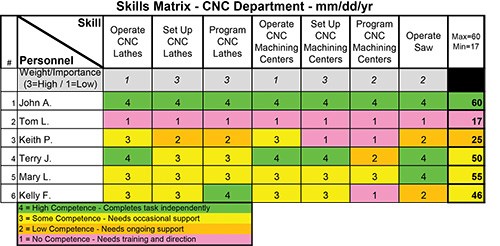The Ongoing Need for Cross-Training
Managing its effectiveness also will help build a highly skilled workforce.
In prior columns, I have discussed the importance to any organization of a well-trained, highly skilled workforce. Although a component of increased employee skills may be provided externally through schools, training organizations and trade associations, skills training is mostly delivered internally. For most jobs, cross-training is the fastest and most effective means of increasing skills. Effective cross-training, during which employees learn from each other, allows job-specific skills to be absorbed and applied in the workplace. As a result, most employees get up to speed at a faster rate. Although not everyone can be a great trainer, almost anyone can show others how they do certain things, and this is the first step to raising the skills of others.
Managing the effectiveness of training is critical to any successful skills-enhancement effort. For a number of years, I have used a simple matrix that has been effective in recording and communicating employee skill levels, as well as targeting areas where further training is required. Color makes the skills matrix highly visual and even more useful.

In the sample skills matrix for a CNC department above, the ratings used and color code employed show that John A. is a truly valuable employee and exhibits a high level of competence in each of the seven skills being evaluated. Terry J. is also a highly skilled employee with high competence in four skills and further competence in others. Mary L. exhibits high or some competence in all skills, while Keith P. and Kelly F. have a varied range of competences. It is likely that Tom L. is a new employee with little competence displayed thus far. The final column provides a numerical total, and each employee’s total is color-coded in line with the color-coding of the individual skills to provide a frame of reference.
All of this information is useful in evaluating the employees in the CNC department, but this matrix assumes that each skill shown is equally important. However, in the “real world,” this is rarely the case. Inevitably, employers value some skills higher than others, so it is helpful to add a weighting to each skill being evaluated. The modification to the matrix here does just that:

In this version of the matrix, a level of importance has been assigned to each skill. Although weighting techniques will vary, I have used three categories, with “3” representing highest importance, “2” moderate importance and “1” lowest importance (although, obviously, each skill is important). The weighting changes the overall competence scale significantly. Whereas in the initial matrix the highest level of competence was reflected in a maximum rating of 28, in the modified matrix the highest weighted level of competence receives a rating of 60. Additionally, the introduction of weighting changes the overall competence rating of two employees. Terry J. was considered an overall “High Competence” performer in the initial matrix, however, when the importance of each skill is factored in, an overall rating of “Some Competence” is more appropriate. Kelly F. actually increases from being a “Low Competence” performer in the initial matrix to a “Some Competence” performer in the revised matrix. The skills in which Kelly F. excels are considered more important than those for which she received a lower rating.
The weighting of skills increases the value of the matrix, and this feature should be considered when developing one of your own. I think you will find a skills matrix to be a useful tool as you strive to continuously upgrade the skills of your employees.
Related Content
How to Grow the Business with Real-Time Job Status Data
ERP systems that focus on making data more accessible can improve communication within a shop, reducing wasteful errors and improving capacity.
Read MoreFinally, A Comprehensive Software Solution Designed for Small Job Shops
Zel X from Siemens is an integrated software application that consolidates collaboration, design, manufacturing, and operations into a comprehensive, easy-to-use solution. From RFQ to delivery, it’s a more efficient way to handle quotes, manage jobs, make parts, and collaborate with teams of all sizes.
Read MoreA Career at the Top Helps Rebuild a Job Shop
A new approach to management propels expansion into Swiss-type and multitasking machining work.
Read MoreIMTS Takeaways From the Modern Machine Shop Editorial Team
The first in-person IMTS in four years left the MMS editorial staff with a lot to digest. Here are a few of our takeaways from the show floor.
Read MoreRead Next
The Cut Scene: The Finer Details of Large-Format Machining
Small details and features can have an outsized impact on large parts, such as Barbco’s collapsible utility drill head.
Read More3 Mistakes That Cause CNC Programs to Fail
Despite enhancements to manufacturing technology, there are still issues today that can cause programs to fail. These failures can cause lost time, scrapped parts, damaged machines and even injured operators.
Read More









.png;maxWidth=300;quality=90)





.png;maxWidth=300;quality=90)







